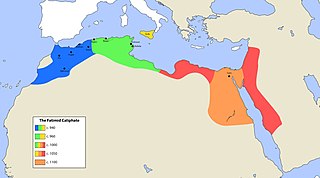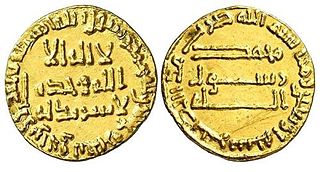
The Fatimid Caliphate was an Ismaili Shia caliphate extant from the tenth to the twelfth centuries AD. Spanning a large area of North Africa, it ranged from the Atlantic Ocean in the west to the Red Sea in the east. The Fatimids, a dynasty of Arab origin, trace their ancestry to Muhammad's daughter Fatima and her husband ‘Ali b. Abi Talib, the first Shi‘ite imam. The Fatimids were acknowledged as the rightful imams by different Isma‘ili communities, but also in many other Muslim lands, including Persia and the adjacent regions. Originating during the Abbasid Caliphate, the Fatimids conquered Tunisia and established the city of "al-Mahdiyya". The Ismaili dynasty ruled territories across the Mediterranean coast of Africa and ultimately made Egypt the center of the caliphate. At its height, the caliphate included – in addition to Egypt – varying areas of the Maghreb, Sudan, Sicily, the Levant, and the Hijaz.

The Fatimid dynasty was an Isma'ili Shi'a dynasty that ruled an extensive empire, the Fatimid Caliphate, between 909 and 1171 CE. Claiming descent from Fatima and Ali, they also held the Isma'ili imamate, claiming to be the rightful leaders of the Muslim community. The line of Nizari Isma'ili imams, represented today by the Aga Khans, claims descent from a branch of the Fatimids.

Abū Jaʿfar ʿAbd Allāh ibn Muḥammad al-Manṣūr (; Arabic: أبو جعفر عبد الله بن محمد المنصور; 95 AH – 158 AH usually known simply as by his laqab Al-Manṣūr was the second Abbasid caliph, reigning from 136 AH to 158 AH succeeding his brother al-Saffah. He is known for founding the 'Round City' of Madinat al-Salam, which was to become the core of imperial Baghdad.

Abu al-Abbas Abdallah ibn Harun al-Rashid, better known by his regnal name Al-Ma'mun, was the seventh Abbasid caliph, who reigned from 813 until his death in 833. He succeeded his half-brother al-Amin after a civil war, during which the cohesion of the Abbasid Caliphate was weakened by rebellions and the rise of local strongmen; much of his domestic reign was consumed in pacification campaigns. Well educated and with a considerable interest in scholarship, al-Ma'mun promoted the Translation Movement, the flowering of learning and the sciences in Baghdad, and the publishing of al-Khwarizmi's book now known as "Algebra". He is also known for supporting the doctrine of Mu'tazilism and for imprisoning Imam Ahmad ibn Hanbal, the rise of religious persecution (mihna), and for the resumption of large-scale warfare with the Byzantine Empire.
The Aftasid dynasty(from the Arabic بنو الأفطس Banu-l'Aftas or Banu al-Aftas) was a Berber Miknasa dynasty centered in Badajoz (1022–1094) in Al Andalus.

Al-Husayn ibn Ahmad ibn Muhammad ibn Zakariyya, better known as Abu Abdallah al-Shi'i, was an Isma'ili missionary (dāʿī) active in Yemen and North Africa, mainly among the Kutama Berbers. He was successful in converting and unifying a large part of the Kutama, leading them to the conquest of Ifriqiya in 902–909 and the overthrow of the Aghlabid dynasty. This allowed the establishment of the Fatimid Caliphate in Ifriqiya under the imam–caliph Abdullah al-Mahdi Billah, but the latter quickly fell out with Abu Abdallah, and had him executed on 28 February 911.

Abū Ḥanīfa al-Nuʿmān ibn Muḥammad ibn Manṣūr ibn Aḥmad ibn Ḥayyūn al-Tamīmiyy (Arabic: النعمان بن محمد بن منصور بن أحمد بن حيون التميمي, generally known as al-Qāḍī al-Nu‘mān or as ibn Ḥayyūn was an Isma'ili jurist and the official historian of the Fatimid Caliphate. He was also called Qaḍi al-Quḍāt "Jurist of the Jurists" and Dāʻī al-Duʻāt "Missionary of Missionaries".

Abū ʿAbd Allāh Muḥammad ibn Ismāʿīl, also known in his own time as al-Maymūn and hence sometimes incorrectly identified as Maymūn al-Qaddāḥ, was the son of Isma'il ibn Ja'far; he was an Ismāʿīlī Imam. The majority of Ismāʿīlī follow his descendants through his son Ahmad al-Wafi. His descendants further founded the Fatimid dynasty, later called the Nizari and Musta'li.

The Imams of Yemen and later also the Kings of Yemen were religiously consecrated leaders belonging to the Zaidiyyah branch of Shia Islam. They established a blend of religious and political rule in parts of Yemen from 897. Their imamate endured under varying circumstances until the republican revolution in 1962. Zaidiyyah theology differed from Isma'ilism or Twelver Shi’ism by stressing the presence of an active and visible imam as leader. The imam was expected to be knowledgeable in religious scholarship, and to prove himself a worthy headman of the community, even in battle if this was necessary. A claimant of the imamate would proclaim a "call" (dawah), and there were not infrequently more than one claimant.

Musa ibn Ja'far al-Kazim, also known as Abū al-Ḥasan, Abū ʿAbd Allāh or Abū Ibrāhīm, was the seventh Imam in Twelver Shia Islam, after his father Ja'far al-Sadiq. He was born in 745 CE in Medina, and his imamate coincided with the reigns of the Abbasid caliphs al-Mansur, al-Hadi, al-Mahdi and Harun al-Rashid. He was repeatedly imprisoned and harassed by the caliphs and finally died in 799 at the al-Sindi ibn Shahiq prison of Baghdad, possibly poisoned at the order of Harun. Ali al-Rida, the eighth Twelver Imam, and Fatemah al-Ma'suma were among his children. Al-Kazim was renowned for his piety and is revered by the Sunni as a traditionist and by the Sufi as an ascetic.
The Yemeni Hamdanids was a series of three families descended from the Arab Banū Hamdān tribe, who ruled in northern Yemen between 1099 and 1174. They were expelled from power when the Ayyubids conquered Yemen in 1174. They were a Shia Ismaili dynasty that followed the Fatimid Caliphs based in Egypt. They were also Hafizi Ismaili as opposed to the Taiyabi Ismaili.

Sahifah of al-Ridha, also known as Sahifat of al-Reza and Sahifatal-Imam al-Ridha, is a collection of 240 hadiths attributed to Ali ibn Musa al-Ridha, the eighth Shia Imam.

ʿAlāʾ ad-Dīn Muḥammad III, more commonly known simply as Ala ad-Din (علاءالدین), son of Jalāl al-Dīn Ḥassan III, was the 26th Nizāri Ismāʿilī Imām. He ruled from 1221 to 1255. He was an esteemed scholar and the spiritual and worldly leader of the Nizari Ismailis, He authored a constitution for the Nizari Ismaili which was practiced for very long time. The intellectual life of Persia flourished significantly during his reign of 34 years. His vision of tolerance, inclusion and pluralism was a rare and shining example for that time. His reign witnessed the beginnings of the Mongol devastations of Persia and the eastern Muslim world. He was murdered under suspicious circumstances and was succeeded by his eldest son Rukn al-Din Khurshah in 1255.
Hamdan Qarmat ibn al-Ash'ath was the eponymous founder of the Qarmatian sect of Isma'ilism. Originally the chief Isma'ili missionary in lower Iraq, in 899 he quarreled with the movement's leadership at Salamiya after it was taken over by Sa'id ibn al-Husayn, and with his followers broke off from them. Hamdan then disappeared, but his followers continued in existence in the Syrian Desert and al-Bahrayn for several decades.
Abu'l-Qāsim al-Ḥasan ibn Faraj ibn Ḥawshab ibn Zādān al-Najjār al-Kūfī, better known simply as Ibn Ḥawshab, or by his honorific of Manṣūr al-Yaman, was a senior Isma'ili missionary from the environs of Kufa. In cooperation with Ali ibn al-Fadl al-Jayshani, he established the Isma'ili creed in Yemen and conquered much of that country in the 890s and 900s in the name of the Isma'ili imam, Abdallah al-Mahdi, who at the time was still in hiding. After al-Mahdi proclaimed himself publicly in Ifriqiya in 909 and established the Fatimid Caliphate, Ibn al-Fadl turned against him and forced Ibn Hawshab to a subordinate position. Ibn Hawshab's life is known from an autobiography he wrote, while later Isma'ili tradition ascribes two theological treatises to him.
Sallamah Umm Abdallah was the main ancestor of the Abbasid dynasty. She was the wife of Muhammad al-Imam, and the mother of Abdallah, who became the second Abbasid caliph as al-Mansur.

This article lists historical events that occurred between 701–800 in modern-day Lebanon or regarding its people.










